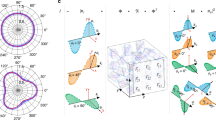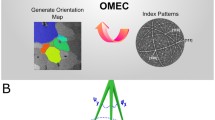Abstract
The advent of high-resolution, high-sensitivity charge couple device (CCD) cameras supplied with fast computers and software algorithms has permitted the routine collection and measurement of EBSD patterns for microcharacterization. Modern camera technology is required for easy acquisition of low intensity patterns and fast pattern analysis makes real-time acquisitions possible. Once the pattern is collected and the Kikuchi bands are identified, there are at least two analyses possible: orientation mapping of known crystal(s) and phase identification of unknown crystals. Although both analyses use EBSD patterns, it has been found that both the hardware and software should be optimized for these different tasks. This chapter will discuss the optimizations deemed necessary for optimal EBSD performance.
Access this chapter
Tax calculation will be finalised at checkout
Purchases are for personal use only
Preview
Unable to display preview. Download preview PDF.
Similar content being viewed by others
Reference
International Center for Diffraction Data, 12 Campus Blvd. Newtown Square, PA 19073–3273 USA, http://www.icdd.com.
Michael, J.R., 1999, Phase identification using EBSD in the SEM: What can be done today and what we hope to do tomorrow, Microscopy and Microanalysis, 5(2):220.
Morawiec, A., 1999, Reliability of automatic orientation determination from Kikuchi patterns, Proc. ICOTOM-12, 1:62.
NORAN Instruments Inc. Application Note “ORKID Analysis of 304 Stainless Steel”.
NORAN Instruments Inc. Application Note “Phase ID of Compressed Powder Sample”.
NORAN Instruments Inc. Sales Bulletin “Forward-Scatter Electron (FSE) Images from EBSD Samples”.
Randle, V., 1993, The Measurement of Grain Boundary Geometry, Institute of Physics Publishing, Bristol.
Schwarzer, R.A., 1997, Automated crystal lattice orientation mapping using a computer-controlled SEM, Micron, 28:249.
Author information
Authors and Affiliations
Editor information
Editors and Affiliations
Rights and permissions
Copyright information
© 2000 Springer Science+Business Media New York
About this chapter
Cite this chapter
Camus, P.P. (2000). Hardware and Software Optimization for Orientation Mapping and Phase Identification. In: Schwartz, A.J., Kumar, M., Adams, B.L. (eds) Electron Backscatter Diffraction in Materials Science. Springer, Boston, MA. https://doi.org/10.1007/978-1-4757-3205-4_11
Download citation
DOI: https://doi.org/10.1007/978-1-4757-3205-4_11
Publisher Name: Springer, Boston, MA
Print ISBN: 978-1-4757-3207-8
Online ISBN: 978-1-4757-3205-4
eBook Packages: Springer Book Archive




